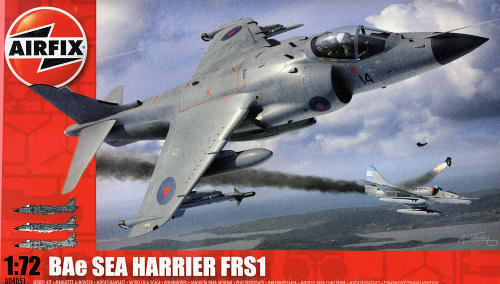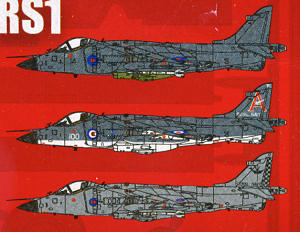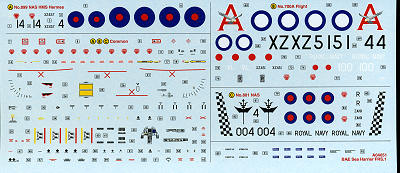
| KIT #: | A04051 |
| PRICE: | $16.95 MSRP |
| DECALS: | Three options |
| REVIEWER: | Scott Van Aken |
| NOTES: | New mold kit |

| HISTORY |
The BAE Systems Sea Harrier is a naval VTOL/STOVL jet fighter, reconnaissance and attack aircraft, a development of the Hawker Siddeley Harrier. It first entered service with the Royal Navy in April 1980 as the Sea Harrier FRS1. The last version was the Sea Harrier FA2. Informally known as the "Shar", the Sea Harrier was withdrawn from Royal Navy service in March 2006 and replaced by the Harrier GR9.
Sea Harriers took part in the Falklands War of 1982, flying from the aircraft carriers HMS Invincible and HMS Hermes. The Sea Harriers were to operate in their primary air defense role with a secondary role of ground attack, with the RAF Harrier GR3 providing the main ground attack force. The Sea Harrier squadrons shot down 21 Argentine aircraft in air-to-air combat with no air-to-air losses, although two Sea Harriers were lost to ground fire and four to accidents.
A number of factors contributed to the failure of the Argentinean fighters to shoot down a Sea Harrier. Although the Mirage III and Dagger jets were considerably faster, the Sea Harrier was more maneuverable. Moreover, the Harrier employed the latest AIM-9L Sidewinder missiles and the Blue Fox radar. The British pilots had superior air-combat training, one manifestation of which was that they noticed Argentinean pilots occasionally releasing weapons outside of their operating parameters. Mirages released external fuel tanks (not weapons) and turned away from conflict with the Sea Harrier. This later reduced their capability to fight an effective campaign against the Sea Harrier due to reduced range.
British aircraft received fighter control from warships in San Carlos Water, although its effectiveness was limited by their being stationed close to the islands, which severely limited the effectiveness of their radar.
Both sides' aircraft were operating in adverse conditions. Argentine aircraft were forced to operate from the mainland because airfields on the Falklands were only suited for propeller-driven transports. In addition, fears partly aroused by the bombing of Port Stanley airport by a British Vulcan bomber added to the Argentineans' decision to operate them from afar. As most Argentine aircraft lacked in-flight refueling capability, they were forced to operate at the limit of their range. The Sea Harriers also had limited fuel reserves due to the tactical decision to station the British carriers out of Exocet missile range and the dispersal of the fleet. The result was that, although an Argentine aircraft could only allow five minutes over the islands to search and attack an objective and without any capable air-to-air missile, a Sea Harrier could stay near to 30 minutes waiting in the Argentine approach corridors.
The Sea Harriers were outnumbered by the available Argentinean aircraft and were on occasion decoyed away by the activities of theEscuadrón Fénix or civilian jet aircraft used by the Argentine Air Force. They had to operate without a fleet early warning system such as AWACS that would have been available to a full NATO fleet in which the Royal Navy had expected to operate.
The result was that the Sea Harriers could not establish complete air superiority and prevent Argentine attacks during day or night, nor could they stop the daily C-130 Hercules transports' night flights to the islands. A total of six Sea Harriers were lost to either ground fire, accidents or mechanical failure during the war.
| THE KIT |
 The purchase of Airfix by Hornby has done a world of good for this once aged and ailing company. Hornby realizes that if a company doesn't produce new items, they are as good as dead, which is what happened to the old Airfix. As a result, they have gone on a campaign of releasing new mold kits on a rather regular basis and choosing subjects in scales not already in their catalogue.
The purchase of Airfix by Hornby has done a world of good for this once aged and ailing company. Hornby realizes that if a company doesn't produce new items, they are as good as dead, which is what happened to the old Airfix. As a result, they have gone on a campaign of releasing new mold kits on a rather regular basis and choosing subjects in scales not already in their catalogue.
That explains the new (to me) Sea Harrier FRS.1 (yes, it takes a while for stuff released in Europe to make it to the US).
Opening the now familiar folded thin cardboard box, one finds three grey sprues and one bag with the clear bits in them. The molding on the kit isn't bad. Though I find the engraved work to be a bit overdone, it is not a deal killer and is well excecuted. I found no flash, not ejector pin marks that would be seen, but I did find a few sink areas on drop tanks and fuselage halves opposite the rather large alignment pins. The ejector marks on the wing halves should be sanded flush to be sure they don't interfere with fit.
The kit has a multitude of options. There are inserts to the intakes that can portray the aux intake doors either flush with the surface or with the upper ones dropped down as they are with the engine off. Gear doors can either be posed full open, with the main ones closed or all of them closed as in flight, though there is no in flight display stand. Other options are open or closed canopy, and the ability to add the gun packs or have the strakes in place (as was the norm in peace-time). In addition to the aforementioned drop tanks, there are Sea Eagle ASMs and two different Sidewinder set ups; one with a single launch rail and one with twin rails.
Detail is fairly good for the cockpit with a three piece bang seat. The landing gear is nicely done and main wheels are flattened. Gear wells have good detail though for most, the doors will be closed making that a moot point. T here is also a posable speed brake and the exhaust nozzles can be rotated. Like all Sea Harrier kits, you can see the huge fan blade through the intake.
here is also a posable speed brake and the exhaust nozzles can be rotated. Like all Sea Harrier kits, you can see the huge fan blade through the intake.
Instructions are very nicely drawn, though frustratingly, Airfix still insists on only supplying Humbrol paint numbers instead of giving a nice conversions chart with real paint information. This does not, however, extend to the full color decal and painting guide, where the shades are called out. There are three markings options. The box art one in overall extra dark sea grey (edsg) from 899 Sq during the Falklands War of 1982, one in the old edsg over white scheme with 700A Sq during 1979 and a third in overall dark sea grey from 1988 with 801 Sq. The decal sheet looks to be first rate so you'll have no issues with it.
decal and painting guide, where the shades are called out. There are three markings options. The box art one in overall extra dark sea grey (edsg) from 899 Sq during the Falklands War of 1982, one in the old edsg over white scheme with 700A Sq during 1979 and a third in overall dark sea grey from 1988 with 801 Sq. The decal sheet looks to be first rate so you'll have no issues with it.
| CONCLUSIONS |
It is nice to see Airfix producing new kit and they have been pretty astute in picking subjects they know will sell well, especially at home. Before this one, the ESCI Sea Harrier was the one to have and while it is still a nice kit, this one from Airfix is surely easier to find and portends to build into a very nice model. What's more, it is at a decent price as were this kit to be redone by a certain Japanese company, it would probably be twice the retail price.
| REFERENCES |
http://en.wikipedia.org September 2010 Thanks to me for providing this one. If you would like your product reviewed fairly and fairly quickly, please contact the editor or see other details in the